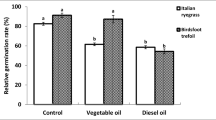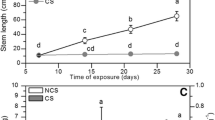Abstract
This study aims to investigate effects of diesel and kerosene on seed germination and seedling growth among coastal wetland plants to select species that can be used for the restoration and revegetation of oil-polluted habitats. Tests on 51 species were performed in Petri dishes containing 0 %, 6 %, 12 %, and 18 % diesel, 20 %, 40 %, and 60 % kerosene; each treatment combination was replicated five times with 20 seeds in each Petri dish. All dishes were held in a growth chamber with 20°C day of 12 h/15°C night of 12 h in 80 % humidity for 20 days for calculating the germination percentage, seedling weight, and seedling vitality. The germination percentage of Rumex stenophyllus decreased significantly in diesel and kerosene treatments. The weights of seedlings treated with diesel and kerosene either increased or decreased in comparison with controls depending on the species. Vitality percentage values were high for seedlings of Chenopodium ficifolium. Thus, herbaceous plant responses to oil treatments are species-specific.

Similar content being viewed by others
References
Amakiri JO, Onofeghara FA (1984) Effects of crude oil pollution on the germination of Zea mays and Capsicum frutescens. Environ Pollut (Ser A) 35:159–167
Banks MK, Schultz KE (2005) Comparison of plants for germination toxicity tests in petroleum-contaminated soils. Water Air Soil Poll 167:211–219
Chen L, Liu X, Zhang X, Liu S, Wei J, Xu G (2013) Response characteristics of seed germination and seedling growth of Acorus tatarinowii under diesel stress. Plant Soil 368:355–363
Dorn PB, Vipond TE, Salanitro JP, Wisniewski HL (1998) Assessment of the acute toxicity of crude oils in soils using earthworms, microtox®, and plants. Chemosphere 37:845–860
Ekundayo EO, Emede TO, Osayande DI (2001) Effects of crude oil spillage on growth and yield of maize (Zea mays L.) in soils of midwestern Nigeria. Plant Food Hum Nutr 56:313–324
Fiorenza S, Oubre CL, Ward CH (2000) Phytoremediation of hydrocarbon-contaminated soil. Lewis Publishers, Boca Raton
Hernández IP, Caona SO, Schroeder RHA, Cruz MCR, Geissen V (2013) Tolerance of four tropical species to heavy petroleum contamination. Water Air Soil Pollut 224:1637–1649
Husseien M, Amer AA, Maghraby AE, Taha NA (2009) Availability of barley straw application on oil spill clean up. Int J Environ Sci Tech 6:123–130
Jordan RE, Payne JR (1980) Fate and weathering of petroleum spills in the marine environment: a literature review and synopsis. Ann Arbor Science Publishers, Ann Arbor
Judy CR, Graham SA, Lin Q, Hou A, Mendelssohn IA (2014) Impacts of macondo oil from deepwater horizon spill on the growth response of the common reed Phragmites australis: a mesocosm study. Mar Pollut Bull 79:69–76
Kim I (1996) Harnessing the green clean. Chem Eng 103:39–41
Mager D, Hernández-Valencia I (2013) Microbial activity during the phytoremediation of a light crude contaminated soil. Rev Fac Agron 30:52–71
Ministry of Environment (2007) Gookminilbo. 2007-12-28
Moore PD, Chapman SB (1986) Methods in plant ecology. Blackwell Scientific Publications, Oxford
Noori AS, Maivan HZ, Alaie E (2014) Leucanthemum vulgare LAM. Germination, growth and mycorrhizal symbiosis under crude oil contamination. Int J Phytoremediation 16:962–970
Pezeshki SR, Hester MW, Lin Q, Nyman JA (2000) The effects of oil spill and clean-up on dominant US Gulf coast marsh macrophytes: a review. Environ Pollut 108:129–139
Sharifi M, Sadeghi Y, Akbarpour M (2007) Germination and growth of six plant species on contamination soil with spent soil. Int J Environ Sci Tech 4:463–470
Siddiqui S, Adams WA (2002) The fate of diesel hydrocarbons in soils and their effect on the germination of perennial ryegrass. Environ Toxicol 17:49–62
Youssef T (2002) Evidence for reduced post-spill recovery by the halophyte Sporobolus iocladus (Ness ex Trin.) Nees in oil-contaminated sediments. Mar Pollut Bull 44:334–339
Zhang CG, Leung KK, Wong YS, Tam NFY (2007) Germination, growth and physiological responses of mangarove plant (Bruguiera gymnorrhiza) to lubricating oil pollution. Environ Exp Bot 60:127–136
Zhao Y, Chen M, Bai J, Li X, Zulfiqar F, Wang Q (2014) Response of microbial community to petroleum stress and phosphate dosage in sediments of Jiaozhou Bay, China. J Ocean Univ China 13:249–256
Author information
Authors and Affiliations
Corresponding author
Rights and permissions
About this article
Cite this article
Kim, K.D. Effects of Diesel and Kerosene on Germination and Growth of Coastal Wetland Plant Species. Bull Environ Contam Toxicol 93, 596–602 (2014). https://doi.org/10.1007/s00128-014-1358-7
Received:
Accepted:
Published:
Issue Date:
DOI: https://doi.org/10.1007/s00128-014-1358-7




